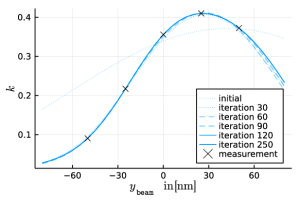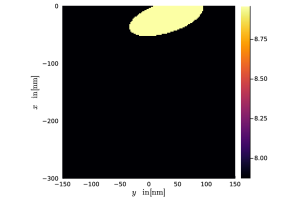Research Highlight 12.23
Reconstruction of an ellipsoidal inclusion in EPMA
EPMA (Electron Probe Microanalysis is a non-destructive technique to determine the chemical composition of material samples in the micro- to nanometer range. Based on intensity measurements of characteristic x-radiation, information about the chemical composition of the sample is obtained. The determination of the underlying chemical composition (reconstruction) constitutes an inverse problem.
In this study, we focus on reconstructing an ellipsoidal inclusion of Copper (Cu) in Iron (Fe). The goal is to reconstruct the inclusion's position, rotation, shape, and interface structure.
The provided plots show (artificially simulated) k-ratio measurements for Iron (orange) and Copper (blue). Additionally, k-ratios for materials at different iterations of the optimization (dashed and dotted lines). Only the measurements marked with black crosses are used for the optimization.


The following plots show the density of the hidden truth (the material we used to artificially simulate the measurements), and an animation of the density of the reconstructed material during the optimization.


We use a k-ratio model, that simulates electron transport using the PN-approximation of the radiative transfer equation, with a subsequent model for x-ray generation and absorption. Computing the gradient of the measurement error with respect to the material parameters represents a computational challenge.
See also: github.com/tam724/pnepma, Contact: Tamme Claus
